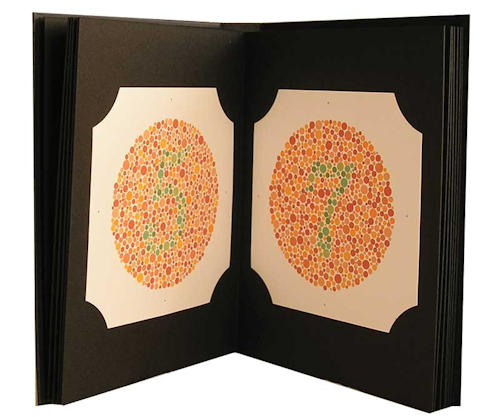
Ishihara Test consists of specially designed circular patterns of colored dots to detect color vision deficiency. Each pattern contains a number or pattern that individuals with color vision deficiency cannot see or may misinterpret. During the test, individuals are shown these patterns and asked to identify which number or pattern they see.
The patterns in this test include various tones and intensities of colors. Individuals with color vision deficiency may experience problems such as the inability to distinguish some colors from others or the incomplete perception of certain patterns. Ishihara Test identifies such color perception disorders by detecting whether individuals have color vision deficiency or not.
Test Yourself
The original version of the test was arranged as colored card prints by Dr. Shinobu Ishihara and set up to be examined in a room with enough daylight. The electronic adaptation on our website may lead to illusions due to monitor light and color settings. While it does not replace an official test, it can be considered a useful method for those curious about their color vision status to self-test. If you encounter any problems during the test, please contact SEVGİGÖZ and proceed to further tests.Setting the computer's graphics card color intensity to higher than 256 and adjusting the brightness and contrast of a monitor with at least 1024x768 resolution to average settings, while wearing reading glasses if necessary, the test should be performed from a distance of 35-40 cm when needed.

Everyone, including those with color vision deficiency, should be able to read the 12 number here comfortably.

People with normal color vision read 8, those with Red-Green color vision deficiency read 3. Those with complete color blindness cannot select any number.

People with normal color vision read 29, those with Red-Green color vision deficiency read 70. Those with complete color blindness cannot select any number.

People with normal color vision read 5, those with Red-Green color vision deficiency read 2. Those with complete color blindness cannot select any number.

People with normal color vision read 3, those with Red-Green color vision deficiency read 5. Those with complete color blindness cannot select any number.

People with normal color vision read 15, those with Red-Green color vision deficiency read 17. Those with complete color blindness cannot select any number.

People with normal color vision read 74, those with Red-Green color vision deficiency read 21. Those with complete color blindness cannot select any number.

People with normal color vision read 6. Those with color vision deficiency either say the wrong number or cannot see any number at all.

People with normal color vision read 45. The majority of those with color vision deficiency either say the wrong number or cannot see any number at all.

People with normal color vision read 5. Those with color vision deficiency either say the wrong number or cannot see any number at all.

People with normal color vision read 7. Those with color vision deficiency either say the wrong number or cannot see any number at all.

People with normal color vision read 16. Those with color vision deficiency either say the wrong number or cannot see any number at all.

People with normal color vision read 73. Those with color vision deficiency either say the wrong number or cannot see any number at all.

Individuals with normal color vision and those with total color blindness cannot read any number. Yellow-green colorblind individuals will see the number 5 here.

Individuals with normal color vision and those with total color blindness cannot read any number. Yellow-green colorblind individuals will see the number 45 here.

Individuals with normal color vision read 26. Those with protanopia or strong protanomaly can see the number 6. Weak protanomalies may be able to select the number 2 but the number 6 is much more distinct. Those with deuteranopia or strong deuteranomaly can see the number 2. Weak deuteranomalies may be able to select the number 6 but the number 2 is much more distinct.

Individuals with normal color vision read 42. Those with protanopia or strong protanomaly can see the number 2. Weak protanomalies may be able to select the number 4 but the number 2 is much more distinct. Those with deuteranopia or strong deuteranomaly can see the number 4. Weak deuteranomalies may be able to select the number 2 but the number 4 is much more distinct.

Individuals with normal vision can follow the red and purple lines extending between the two X marks. In protanopia and advanced protanomaly, only the purple path can be followed. In mild protanomaly, the red path can be selected with difficulty. In deuteranopia and advanced deuteranomaly, only the red path can be followed. In mild deuteranopia, the purple path can be selected with difficulty.

Most red-green color blind individuals see and follow a path between the two X marks. Normals and total color blind individuals cannot find such a path.

Normals can easily follow the winding blue-green path between the two X marks. In most cases of color vision deficiencies, this path cannot be followed at all, or there are deviations and incorrect directions during tracking.

Normals can easily follow the winding orange path between the two X marks. In most cases of color vision deficiencies, this path cannot be followed at all, or there are deviations and incorrect directions during tracking.

Normals can find the merging path between blue-green and yellow-green easily. Red-green deficiencies follow the line that merges blue-green into purple. Total color blind individuals cannot follow any line.

Normals can follow the merging purple and orange line between the two X marks. In red-green deficiencies, the merging path between purple and blue-green is followed. In total color blindness and advanced deficiencies, no path can be found.

Both normals and color-blind individuals can follow the winding orange line between the two X marks.




